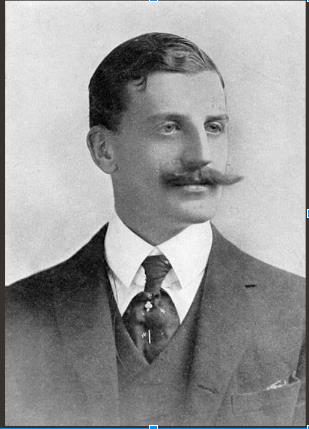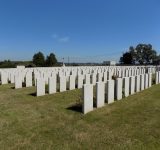Personal Details
Viscount Henry Willam Crichton, born in Lisnaskea, Fermanagh, Ireland on 30 September 1872, the son of John Henry Crichton, 4th Earl of Erne and Florence Mary Crichton, Viscountess of Crom Castle, Ireland.
Husband of Mary Cavendish, Viscountess Crichton (married 1903) of Combermere Abbey, Burleydam, Cheshire; father to Mary Kathleen and John Henry George.
Henry’s brother in law Lord Hugh William Grosvenor was killed on the previous day.
Military Details
Regiment : Royal Horse Guards
Rank : Major (brevet Lieutenant Colonel)
Service Number :
Killed in action; Belgium 31 October 1914 Aged 42
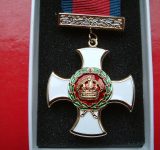
The Distinguished Service Order (DSO) is a military decoration of the United Kingdom, and formerly of other parts of the Commonwealth of Nations, awarded for meritorious or distinguished service by officers of the armed forces during wartime, typically in actual combat.
Instituted on 6 September 1886 by Queen Victoria in a Royal Warrant published in The London Gazette on 9 November, the first DSOs awarded were dated 25 November 1886. It is typically awarded to officers ranked major (or its equivalent) or higher, but the honour has sometimes been awarded to especially valorous junior officers. During the First World War, 8,981 DSOs were awarded, each award being announced in The London Gazette.
The order was established for rewarding individual instances of meritorious or distinguished service in war. It was a military order, until recently for officers only, and normally given for service under fire or under conditions equivalent to service in actual combat with the enemy, although it was awarded between 1914 and 1916 under circumstances which could not be regarded as under fire (often to staff officers, which caused resentment among front-line officers). After 1 January 1917, commanders in the field were instructed to recommend this award only for those serving under fire. Prior to 1943, the order could be given only to someone mentioned in despatches. The order is generally given to officers in command, above the rank of captain. A number of more junior officers were awarded the DSO, and this was often regarded as an acknowledgement that the officer had only just missed out on the award of the Victoria Cross. In 1942, the award of the DSO was extended to officers of the Merchant Navy who had performed acts of gallantry while under enemy attack.
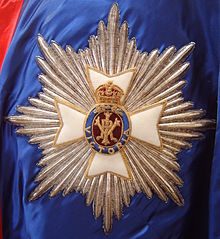
The Royal Victorian Order is a dynastic order of knighthood established in 1896 by Queen Victoria. It recognises distinguished personal service to the monarch of the Commonwealth realms, members of the monarch's family, or to any viceroy or senior representative of the monarch. The present monarch, Queen Elizabeth II, is the Sovereign of the order, its motto is Victoria, and its official day is 20 June. The order's chapel is the Savoy Chapel in London.
There are no limits on the number honoured, and admission remains at the sole discretion of the monarch, with each of the order's five grades and one medal with three levels representing different levels of service. While all those honoured may use the prescribed styles of the order—the top two grades grant titles of knighthood, and all grades accord distinct post-nominal letters—the Royal Victorian Order's precedence amongst other honours differs from realm to realm and admission to some grades may be barred to citizens of those realms by government policy.
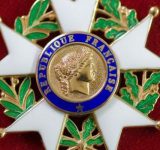
The Legion of Honour, full name, National Order of the Legion of Honour (French: Ordre national de la Légion d'honneur), is the highest French order of merit for military and civil merits, established in 1802 by Napoléon Bonaparte.
The order's motto is "Honneur et Patrie" ("Honour and Fatherland") and its seat is the Palais de la Légion d'Honneur next to the Musée d'Orsay, on the left bank of the River Seine in Paris.
The order is divided into five degrees of increasing distinction: Chevalier (Knight), Officier (Officer), Commandeur (Commander), Grand Officier (Grand Officer) and Grand-Croix (Grand Cross).

The 1914 Star (also known as 'Pip') was authorised under Special Army Order no. 350 in November 1917 and by an Admiralty Fleet Order in 1918, for award to officers and men of the British and Indian Expeditionary Forces who served in France or Belgium between 5 August and midnight of 22–23 November 1914. The former date is the day after Britain's declaration of war against the Central Powers, and the closing date marks the end of the First Battle of Ypres.
The 1914–15 Star (also known as 'Pip') was instituted in December 1918 and was awarded to officers and men of British and Imperial forces who served against the Central European Powers in any theatre of the Great War between 5 August 1914 and 31 December 1915. The period of eligibility was prior to the introduction of the Military Service Act 1916, which instituted conscription in Britain.
The British War Medal (also known as 'Squeak') was a silver or bronze medal awarded to officers and men of the British and Imperial Forces who either entered a theatre of war or entered service overseas between 5th August 1914 and 11th November 1918 inclusive. This was later extended to services in Russia, Siberia and some other areas in 1919 and 1920. Approximately 6.5 million British War Medals were issued. Approximately 6.4 million of these were the silver versions of this medal. Around 110,000 of a bronze version were issued mainly to Chinese, Maltese and Indian Labour Corps. The front (obv or obverse) of the medal depicts the head of George V. The recipient's service number, rank, name and unit was impressed on the rim.
The Allied Victory Medal (also known as 'Wilfred') was issued by each of the allies. It was decided that each of the allies should each issue their own bronze victory medal with a similar design, similar equivalent wording and identical ribbon. The British medal was designed by W. McMillan. The front depicts a winged classical figure representing victory. Approximately 5.7 million victory medals were issued. Interestingly, eligibility for this medal was more restrictive and not everyone who received the British War Medal ('Squeak') also received the Victory Medal ('Wilfred'). However, in general, all recipients of 'Wilfred' also received 'Squeak' and all recipients of The 1914 Star or The 1914/1915 Star (also known as 'Pip') also received both 'Squeak' and 'Wilfred'. The recipient's service number, rank, name and unit was impressed on the rim.
Further Information
Viscount Crichton is now assumed to have been killed in action on 31 October 1914. However, his death was not formally reported at the time and his mother-in-law, Katherine Viscountess of Westminster went to great lengths to trace his and her son's (Lord Hugh Grosvenor) whereabouts. Probate to his will was finally granted in 1916. The following newspaper articles highlight this period:
Report in the Nantwich Guardian of the efforts being made by Lord Grosvenor's mother to establish his whereabouts
"Katherine Duchess of Westminster is untiring in her inquiries about her son, Lord Hugh Grosvenor and her son-in-law, the Earl of Erne, both of whom have been missing for some months after having taken part in engagements in France. Last week she visited a corporal-of-horse in Captain Lord Hugh's squadron of the 1st Life Guards. This man claims to have seen Lord Hugh wounded when his squadron was forced to retire on October 31st, when the Germans were making their desperate rush for Calais. This goes a little farther beyond what was already known and furnishes more hopeful probabilities."
Nantwich Guardian 15 October 1915
Report in the Sheffield Independent 27 March 1919 finally confirming Lord Grosvenor's death
"OCTOBER '14 TO MARCH '19
Lady Hugh Grosvenor whose husband's death is now officially concluded to have taken place in October 1914, when he was listed as 'missing' along with her brother, Lord Crichton, had long ago abandoned all hope of his being alive. In October 1917, as nothing had been heard of him, Lady Hugh after three years of anxiety, was reluctantly compelled to believe he was no more. She then resigned his prospective candidature for Macclesfield. He was the Duke of Westminster's step-uncle."
Sheffield Independent 27 March 1919
Taken from Forces War Records
CRICHTON, HENRY WILLIAM, Viscount, M.V.O., D.S.O., Major and Brevet Lieut.-Col., Royal Horse Guards; Extra Equerry to His Majesty the King etc. eldest son of John Henry, 4th Earl Erne, K.P., P.C., by his wife, Lady Florence Mary (21, Knightsbridge, S.W.), nee Cole, daughter of William Willoughby, 3rd Earl of Enniskillen, F.R.S.; born at Crom Castle 30 Sept. 1872; educated Eton; and the Royal Military College, Sandhurst; gazetted 2nd Lieut. Royal Horse Guards, 5 May, 1894, and promoted Lieut. 6 Feb. 1895, Capt. 24 Feb. 1900, Major 7 May 1910, and Brevet Lieut.-Col. 7 Nov. 1914; was Adjutant 8 Dec. 1896 to 6 Oct. 1899; A.D.C. to H.M. when Duke of Cornwall during his Colonial Tour, 1901; Equerry 19 Nov. 1901 to 12 May 1908, and Extra Equerry 1 April 1909 to 6 May 1910 to H.M. when Prince of Wales etc., and Exra Equerry to H.M. the Kng from 10 June 1910; M.V.O. (4th class) 1906; served (1) in the South African War 1899-1900, on Staff; was A.D.C. to Major-General Commanding Cavalry Brigade, Natal, 7 Oct. 1899 to 24 Jan. 1901; took part in Defence of Ladysmith; operations in Natal, March to June 1900, and in the Transvaal east of Pretoria, July to Nov. 1900 (mentioned in Despatches (London Gazette, 8 Feb. 1901); D.S.O.; Queen’s Medal with five clasps); and (2) in the European War, Aug. to Nov. 1914 (mentioned in Despatches (London Gazettes, 19 Oct. 1914 and 17 Feb. 1915), and was officially reported missing 1 Nov. 1914.
For over a year it was supposed that he might be a prisoner in Germany, and his father dying 2 Dec. 1914, he appeared in the Peerages for 1915-16 as 5th Earl Erne. According to a list received by the Foreign Office from the German Government through the United States Embassy, Lord Crichton fell in Oct. 1914 and was buried in the cemetery of Wervice Nord (Grave No. 1596). His death, therefore, has been accepted as having ocurred on or about 31 Oct. 1914. From a statement issued by the family in Feb. 1917, it appears that Lord Crichton disappeared at 2 a.m. at Wytschaete. Captain Bowlby, a brother officer of the Horse Guards, since killed, stated that during the fighting round Ypres he and Lord Crichton went out to bring in some men whom Lord Crichton believed belonged to his own regiment. Captain Bowlby thought that they were Germans, and Lord Crichton courageously went out. He was seen riding up to them; they closed around him, and he did not return. Corpl. Coppinger, Royal Horse Guards, who was in hospital in Boulogne after the incident, stated that he was within 50 yards of Lord Crichton when they had retired from the trenches. Lord Crichton went off on a horse to get communcation with other troops and ran straight into the Germans. It was dark at the time, but Coppinger could hear German voices. Another soldier of Coppinger’s party said that he heard a German say in good English: “Most delighted!” Coppinger added that there was no sound of a shot or a struggle, and he had no doubt that Lord Crichton fell unharmed into German hands.
He married 10 June 1903, Lady Mary Cavendish (Crom Castle, Newton Butler, Fermanagh; 21, Knightsbridge, S.W.) nee Grosvenor, daughter of Hugh Lupus, 1st Duke of Westminster, K.G., and had three children: George David Hugh born 12 (died 18) May 1904; John Henry George, now 5th Earl Erne (for whom H.M. the King was sponsor), born 22 Nov. 1907, and Mary Kathleen (for whom H.M. the Queen was sponsor), born 8 July 1905.
If you can provide any further information on Viscount Henry William Crichton please get in touch by leaving a comment below, using our Contact Form or by calling in to Whitchurch Heritage Centre.
Information provided by Whitchurch Museum and Archives

